![]() Catalogs for precast concrete elements
Catalogs for precast concrete elements
![]() "General" tab
"General" tab
Created on:
Date the record was created.
Last modified:
Date the record was last changed.
Name:
You can enter any name. You can find this name in the Type list box of the basic parameters for slab element design if the Description box is empty. Thus, you can enter a short name for the catalog and a detailed description for the design.
Description:
You can enter any name. You can find this name in the Type list box of the basic parameters for slab element design.
Panel thickness:
The standard value for panel thickness.
Max. panel length:
Maximum value for the panel length. If this value is exceeded during design, the program displays a message.
Longitudinal section / End face section:
Selection box of the joint section catalog. These sections are used for element design. All the edges to which you assign the longitudinal section get the Smooth edge or Stop position attribute.
To assign this attribute to a panel edge without profiling, you must define a "smooth" section in the joint section catalog and assign it here.
You can use the support conditions to modify the sections applied to the sides of the support. The sections at the joints can be modified by means of the Modify Parameters, Basic Reinforcement tool.
You can define how to display and label sections in the configurations.
Standard panel width:
The standard value for panel width. This value is used for uncut panels in element design.
Min. fitted panel width:
Minimum value for the panel width. If this value cannot be complied with, the program creates a strip made of in-situ concrete or two fitted panels (depending on your settings).
Max. fitted panel width:
Maximal value for the width of a cut panel. If this value is exceeded, the program creates two fitted panels.
Min. offset from cut to web at start or end:
Minimum value for the left or right distance from cuts in areas of hollow blocks to the web. The program uses this entry to calculate the widths of fitted panels and positions of openings.
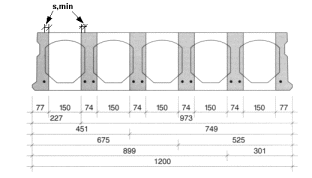
Opt for cut in axis:
When generating fitted panels, the program tries to cut the panels in the area of the hollow block axis and to use permissible values for the support widths. If this results in an illegal panel, the program uses the minimum distances from the cuts to the webs.
Dead weight for simplified calculation:
When you enter a value that is not equal to 0.000 [to/m2], the program uses a simplified method to compute the weight, ignoring closed hollow blocks when computing the weight and volume of the precast element. In this case, the program computes the weight of the element by multiplying the weight of the panel area by the value for the dead weight specified here. To compute the volume, the program divides the computed weight by the Specific weight of reinforced concrete defined in the Concrete grade catalog.
![]() "Recesses 1" tab
"Recesses 1" tab
Recesses that are larger than the ones defined here can be created by means of steel headers. The program uses the recess width to define the number of webs that will be cut.
Small recess between two webs:
Maximum length of recesses which are not wider than the space available between two webs.
Medium-sized recesses:
Minimum edge offsets for recesses which are wider than small recesses; however, these recesses do not exceed the limits defined on the Recesses 1 and Recesses 2 tabs.
By defining these minimum offsets, you can prevent nonproducible or failure-prone panel webs from being generated because the program extends the recesses as far as the panel edge. However, the program considers these offsets only if it is not allowed to move the medium-sized recesses.
Thus, recesses at room edges, which result in narrow webs (due to the support) will not be treated as lateral or centered recesses. Rather, these recesses retain their positions.
Based on these minimum offsets, you can turn recesses in midspan into support recesses in the head region or into lateral recesses and vice versa.
Support recess at corner / head:
Maximum dimensions for recesses as shown in the illustration.
If it is not allowed to move the recess and if, in the case of recesses in the head region, the edge offset to the longitudinal side is smaller than the minimum offset specified for medium-sized recesses, the program creates a recess in the corner.
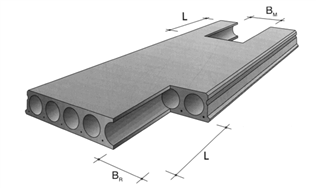
Note: You cannot apply the two recess options to one and the same panel!
Projecting panels in corner and head regions:
Maximum height:width ratio permitted for projecting panel parts in corner or head regions resulting from support recesses in head regions. The program checks each projecting part. These parts must always be at right angles and parallel to the span direction.
If a projecting part does not meet these criteria, the panel gets the identifier for the illegal geometry element state. You must then specify how to continue (for example, placing mandatory points, …).
![]() "Recesses 2" tab
"Recesses 2" tab
Recesses that are larger than the ones defined here can be created by means of steel headers. The program uses the recess width to define the number of webs that will be cut.
Recess in center of panel:
Maximum dimensions and minimum edge offset for recesses as shown in the illustration.
If the minimum edge offset is not complied with and it is allowed to move the recess, the program moves the recess to the specified offset during design.
If it is not allowed to move the recess and the edge offset to the front is larger than the minimum offset specified for medium-sized recesses on the Recesses 1 tab, the program displays a message during design.
If it is not allowed to move the recess and the edge offsets are smaller than the minimum values specified for medium-sized recesses on the Recesses 1 tab, the program creates a recess in the corner, head region, or lateral region.

Lateral recess:
Maximum dimensions and minimum edge offset for recesses as shown in the illustration.
If the minimum edge offset is not complied with and it is allowed to move the recess, the program moves the recess to the specified offset during design.
If it is not allowed to move the recess and the edge offset to the front is larger than the minimum offset specified for medium-sized recesses on the Recesses 1 tab, the program displays a message during design.
If it is not allowed to move the recess and the edge offset to the front is smaller than the minimum offset specified for medium-sized recesses on the Recesses 1 tab, the program creates a recess in the corner.
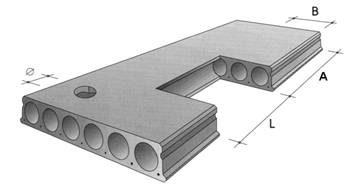
![]() "Hollow blocks" tab
"Hollow blocks" tab
Number, type, and position of hollow blocks. You can define up to six areas.
Number:
Number of hollow blocks for the current area.
Type:
Selection box of the hollow block catalog.
x-offset, y-offset:
Axis spacing between hollow blocks and the panel edge or the axis of the last hollow block in the x-direction; edge offset from hollow blocks to the bottom panel edge in the y-direction for the current area.
![]() "Mounting hooks, lifting bolts" tab
"Mounting hooks, lifting bolts" tab
The mounting hooks, lifting bolts can be calculated using two different algorithms. You can either calculate the mounting hooks, lifting bolts solely by panel weight, or you can calculate them depending on the panel width and panel weight. The Calculation by dialog box is used for this purpose with the Weight and Gew+Bre (= Weight and width). The tab content will vary depending on the selection made.
![]() "Insulation" tab
"Insulation" tab
Type
Thickness / Material:
To apply insulation to the bottom side of the panel, enter the Thickness and select the required insulation material in the Material list box.
Note: If you cannot find the required insulation material, the thickness entered does not match the thickness for the required material in the insulation material catalog.
If the Define dimensions option is selected for the insulation material on the Placement tab, the program places insulating boards. Otherwise, the program creates one insulating board with the dimensions of the precast element.
End faces / Longitudinal sides
You can specify parameters for the concrete supports at the bottom side of the panel. You can make separate settings for end faces and longitudinal sides. The following variants are available: Not used, Concrete pads, and Concrete beams. Depending on the selected variant, you can define the following parameters:
Note: The numbers you enter for File no. and Entry must be the same as those in the fixture catalog in Allplan.
The fixture you select for the Concrete pad must be a group fixture that consists of at least one linear fixture with the Interaction with precast element - Positive (merging) setting. This fixture defines the outline of the concrete pad in plan. The length of the defined linear component must be the same as the thickness defined for the appropriate insulating layer.
The fixture for the Concrete beam must be a linear fixture with the Interaction with precast element - Positive (merging) setting. This fixture defines the outline of the concrete pad in elevation.
![]() "Bond" tab
"Bond" tab
End faces / Longitudinal sides
You can specify parameters for the recesses at the upper side of the panel. You can make separate settings for end faces and longitudinal sides. The following variants are available: Not used, Fixture, and Parameters. Depending on the selected variant, you can define the following parameters:
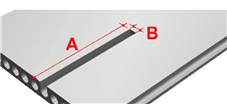
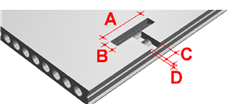
Note: The numbers you enter for File no. and Entry must be the same as those in the fixture catalog in Allplan.
![]() "->Fact." tab
"->Fact." tab
Assignment of entries to factories.
The selected entry applies to the selected factories only. If no factory is selected, the entry applies to all factories.
|
(C) ALLPLAN GmbH |
Privacy policy |